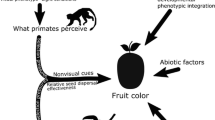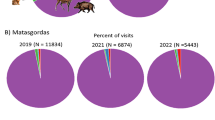Abstract
Many researchers have posited the existence of fruit syndromes – sets of fruit traits such as colour, odour and size that match the behaviour, morphology and sensory adaptations of their key seed dispersal agents. Implicit in this hypothesis is the idea that dispersers have been the selective force behind fruit syndromes, based on their feeding preferences and behaviour. These hypotheses are contentious, as many argue that fruits, unlike flowers, are dispersed by a high diversity of animals and are thus unlikely to converge upon sets of fruit traits that are attractive to only a subset of the potential disperser population. Empirical evidence for the existence of fruit syndromes is mixed. For over 30 years, researchers have identified the traits of “primate fruits” – fruits that are exclusively or primarily dispersed by primates. Here, we review the primate fruit syndrome hypothesis in the history of primate seed dispersal studies. We additionally suggest that because of recent technological advances that allow for the quantification of fruit traits, coupled with the importance of primates as seed dispersers and the relative ease with which it is possible to quantify primate seed dispersal relative to other taxa, primates are excellent taxa with which to test the fruit syndrome hypothesis.
Access this chapter
Tax calculation will be finalised at checkout
Purchases are for personal use only
Similar content being viewed by others
References
Balcomb SR, Chapman CA (2003) Bridging the gap: influence of seed deposition on seedling recruitment in a primate-tree interaction. Ecol Monogr 73(4):625–642
Barraclough TG, Savolainen V (2001) Evolutionary rates and species diversity in flowering plants. Evolution 55(4):677–683
Brodie JF (2017) Evolutionary cascades induced by large frugivores. Proc Natl Acad Sci 114(45):11998–12002
Chapman CA (1995) Primate seed dispersal: coevolution and conservation implications. Evol Anthropol 4:74–82
Chapman CA, Chapman LJ (1996) Frugivory and the fate of dispersed and non-dispersed seeds of six African tree species. J Trop Ecol 12:491–504
Chapman LJ, Chapman CA, Wrangham RW (1992) Balanites-wilsoniana: elephant dependent dispersal. J Trop Ecol 8:275–283
Chapman CA, Chapman LJ, Struhsaker TT, Zanne AE, Clark CJ, Poulsen JR (2005) A long-term evaluation of fruiting phenology: importance of climate change. J Trop Ecol 21:31–45
Connell JH, Green PT (2000) Seedling dynamics over thirty-two years in a tropical rain forest tree. Ecology 81(2):568–584
Corlett RT, Lucas PW (1990) Alternative seed-handling strategies in primates - seed spitting by long-tailed macaques (Macaca fascicularis). Oecologia 82:166–171
Curran LM, Leighton M (2000) Vertebrate responses to spatiotemporal variation in seed production of mast-fruiting dipterocarpaceae. Ecol Monogr 70(1):101–128
Dew JL, Wright P (1998) Frugivory and seed dispersal by four species of primates in Madagascar's eastern rain forest. Biotropica 30(3):425–437
Estrada A, Coates-Estrada R (1996) Frugivory by howling monkeys (Alouatta palliata) at los Tuxtlas, Mexico: dispersal and the fate of seeds. In: Estrada A, Fleming TH (eds) Frugivores and seed dispersal. Dordrecht Publishers, New York
Fischer K, Chapman C (1993) Frugivores and fruit syndromes: differences in patterns at the genus and species level. Oikos 66(3):472–482
Fleming T, Breitwisch R, Whitesides G (1987) Patterns of tropical vertebrate frugivore diversity. Annu Rev Ecol Syst:91–109
Galetti M, Guevara R, Côrtes MC, Fadini R, Von Matter S, Leite AB, Labecca F, Ribeiro T, Carvalho CS, Collevatti RG (2013) Functional extinction of birds drives rapid evolutionary changes in seed size. Science 340(6136):1086–1090
Gautier-Hion A (1984) La dissemination des graines par les cercopithecides forestier Africans. Terre et Vie 39:159–165
Gautier-Hion A, Duplantier JM, Quris R, Feer F, Sourd C, Decous JP, Doubost G, Emmons L, Ehrard C, Hecketswiler P, Moungazi A, Roussilhon C, Thiollay JM (1985) Fruit characters as a basis of fruit choice and seed dispersal in a tropical forest vertebrate community. Oecologia 65:324–337
Hamilton AC (1991) A field guide to Uganda forest trees. Makerere University Printery, Kampala
Harms KE, Condit R, Hubbell SP, Foster RB (2001) Habitat associations of trees and shrubs in a 50-ha neotropical forest plot. J Ecol 89:947–959
Herrera CM (1982) Seasonal variations in the quality of fruits and diffuse coevolution between plants and avian dispersers. Ecology 63:772–785
Herrera C (1985) Determinants of plant-animal coevolution: the case of mutualistic dispersal of seeds by vertebrates. Oikos 44:132–141
Herrera C (1987) Vertebrate-dispersed plants of the Iberian Peninsula: a study of fruit characteristics. Ecol Monogr 57(4):305–331
Herrera C (1992) Interspecific variation in fruit shape: allometry, phylogeny, and adaptation to dispersal agents. Ecology 73(5):1832–1841
Hiramatsu C, Melin AD, Aureli F, Schaffner CM, Vorobyev M, Matsumoto Y, Kawamura S (2008) Importance of achromatic contrast in short-range fruit foraging of primates. PLoS One 3:e3356
Howe HF, Miriti MN (2004) When seed dispersal matters. Bioscience 54(7):651–660
Howe HF, Smallwood J (1982) Ecology of seed dispersal. Annu Rev Ecol Syst 13:201–228
Iwao K, Rausher MD (1996) Evolution of plant resistance to multiple herbivores: quantifying diffuse coevolution. Am Nat 149:316–335
Jacobs GH (2008) Primate color vision: a comparative perspective. Vis Neurosci 25:619–633
Janson CH (1983) Adaptation of fruit morphology to dispersal agents in a neotropical rainforest. Science 219:187–189
Janzen DH (1980) When is it coevolution? Evolution 34:611–612
Jordano P (1995) Angiosperm fleshy fruits and seed dispersers: a comparative analysis of adaptation and constraints in plant-animal interactions. Am Nat 145(2):163–191
Jordano P (2000) Fruits and frugivory. In: Fenner M (ed) Seeds: the ecology of regeneration in plant communities. CAB International, Wallingford, pp 125–165
Julliot C (1996) Seed dispersal by red howling monkeys (Alouatta seniculus) in the tropical rain forest of French Guiana. Int J Primatol 17(2):239–258
Lambert JE (1997) Fruit processing and seed dispersal by chimpanzees (Pan troglodytes schweinfurthii) and redtail monkeys (Cercopithecus ascanius schmidti) in the Kibale National Park, Uganda. University of Illinois, Urbana
Lambert JE, Garber PA (1998) Evolutionary and ecological implications of primate seed dispersal. Am J Primatol 45:9–28
Lieberman M, Lieberman D (1986) An experimental study of seed ingestion and germination in a plant-animal assemblage in Ghana. J Trop Ecol 2(02):113–126
Lieberman D, Hall J, Swaine M, Lieberman M (1979) Seed dispersal by baboons in the Shai Hills, Ghana. Ecology 60(1):65–75
Loiselle BA, Blendinger PG, Blake JG, Ryder TB (2007) Ecological redundancy in seed dispersal systems: a comparison between Manakins (Aves: Pipridae) in two tropical forests. In: Dennis AJ, Schupp EW, Green R, Westcott DW (eds) Seed dispersal: theory and its application in a changing world. CABI Publishing, Oxfordshire, pp 178–196
Lomascolo SB, Levey D, Kimball RT, Bolker BM, Alborn HT (2010) Dispersers shape fruit diversity in Ficus (Moraceae). Proc Natl Acad Sci 107:14668–14672
Melin AD, Fedigan LM, Hiramatsu C, Hiwatashi T, Parr N, Kawamura S (2009) Fig foraging by dichromatic and trichromatic Cebus capucinus in a tropical dry forest. Int J Primatol 30(6):753–775
Melin AD, Hiramatsu C, Parr NA, Matsushita Y, Kawamura S, Fedigan LM (2014) The behavioral ecology of color vision: considering fruit conspicuity, detection distance and dietary importance. Int J Primatol 35(1):258–287
Nevo O, Heymann EW (2015) Led by the nose: olfaction in primate feeding ecology. Evolutionary Anthropology: Issues, News, and Reviews 24(4):137–148
Nevo O, Garri RO, Salazar LTH, Schulz S, Heymann E, Ayasse M, Laska M (2015) Chemical recognition of fruit ripeness in spider monkeys (Ateles geoffroyi). Sci Rep 5:14895
Nevo O, Heymann EW, Schulz S, Ayasse M (2016) Fruit odor as a ripeness signal for seed-dispersing primates? A case study on four Neotropical plant species. J Chem Ecol 42(4):323–328
Riba-Hernández P, Stoner KE, Lucas PW (2005) Sugar concentration of fruits and their detection via color in the Central American spider monkey (Ateles geoffroyi). Am J Primatol 67(4):411–423
Ridley HN (1930) The dispersal of plants throughout the world. Reeve, Ashford
Stevens M, Paraga CA, Cuthill IC, Partridge JC, Troscianko TOMS (2007) Using digital photography to study animal coloration. Biol J Linn Soc 90(2):211–237
Stevens M, Stoddard MC, Higham JP (2009) Studying primate color: towards visual system-dependent methods. Int J Primatol 30(6):893–917
Tamboia T, Cipollini ML, Levey DJ (1996) An evaluation of vertebrate seed dispersal syndromes in four species of black nightshade (Solanum sect. Solanum). Oecologia 107(4):522–532
Valenta K (2014) Endemic fruit signals in Madagascar drive variation in Eulemur fulvus foraging behaviour and efficiency. Toronto,
Valenta K, Fedigan LM (2010) Spatial patterns of seed dispersal by white-faced capuchins in Costa Rica: evaluating distant-dependent seed mortality. Biotropica 42(2):223–228
Valenta K, Burke RJ, Styler SA, Jackson DA, Melin AD, Lehman SM (2013) Colour and odour drive fruit selection and seed dispersal by mouse lemurs. Sci Rep 3:1–5
Valenta K, Brown KA, Melin AD, Monckton SK, Styler SA, Jackson DA, Chapman CA (2015a) It’s not easy being blue: are there olfactory and visual trade-offs in plant signalling? PLoS One 10(6):e0131725
Valenta K, Brown KA, Rafaliarison RR, Styler SA, Jackson D, Lehman SM, Chapman CA, Melin AD (2015b) Sensory integration during foraging: the importance of fruit hardness, colour, and odour to brown lemurs. Behav Ecol Sociobiol 69(11):1855–1865
Valenta K, Miller CN, Monckton SK, Melin AD, Lehman SM, Styler SA, Jackson DA, Chapman CA, Lawes MJ (2016a) Fruit ripening signals and cues in a Madagascan dry forest: haptic indicators reliably indicate fruit ripeness to dichromatic lemurs. Evol Biol:1–12
Valenta K, Nevo O, Martel C, Chapman CA (2016b) Plant attractants: integrating insights from pollination and seed dispersal ecology. Evol Ecol: 1–19
Van der Pijl L (1969) Evolutionary action of tropical animals on the reproduction of plants. Biol J Linn Soc 1(1-2):85–96
van Schaik CP, Terborgh JW, Wright SJ (1993) The phenology of tropical forests: adaptive significance and consequences for primary consumers. Annu Rev Ecol Syst 24:353–377
Walker BH (1992) Biodiversity and ecological redundancy. Conserv Biol 6(1):18–23
Worman CO, Chapman CA (2005) Seasonal variation in the quality of a tropical ripe fruit and the response of three frugivores. J Trop Ecol 21:689–697
Wrangham RW, Chapman CA, Chapman LJ (1994) Seed dispersal by forest chimpanzees in Uganda. J Trop Ecol 10:355–368
Zanne AE, Chapman CA, Kitajima K (2005) Evolutionary and ecological correlates of early seedling morphology in east African trees and shrubs. Am J Bot 92(6):972–978
Acknowledgements
We dedicate this paper to Dr. Linda M. Fedigan who was influential in the careers of both authors despite the fact that they represent two generations of scientists. We are grateful to Dr. Eckhard Heymann and one anonymous reviewer for their helpful comments to improve the manuscript. Funding during the preparation of the manuscript was provided by the Canada Research Chairs Program, Natural Sciences and Engineering Research Council of Canada and the Fonds Québécois de la Recherché sur la Nature et les Technologies.
Author information
Authors and Affiliations
Corresponding author
Editor information
Editors and Affiliations
Rights and permissions
Copyright information
© 2018 Springer Nature Switzerland AG
About this chapter
Cite this chapter
Valenta, K., Chapman, C.A. (2018). Primate-Plant Mutualisms: Is There Evidence for Primate Fruit Syndromes?. In: Kalbitzer, U., Jack, K. (eds) Primate Life Histories, Sex Roles, and Adaptability. Developments in Primatology: Progress and Prospects. Springer, Cham. https://doi.org/10.1007/978-3-319-98285-4_12
Download citation
DOI: https://doi.org/10.1007/978-3-319-98285-4_12
Published:
Publisher Name: Springer, Cham
Print ISBN: 978-3-319-98284-7
Online ISBN: 978-3-319-98285-4
eBook Packages: Biomedical and Life SciencesBiomedical and Life Sciences (R0)




